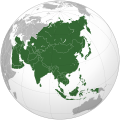 | |
| Area | 21,780,142 km2 (8,409,360 sq mi) |
|---|---|
| Population | 375,278,947 (2021 est.) |
| Population density | 16.5/km2 (42.7/sq mi) |
| GDP (nominal) | $27.5 trillion (2022) [1] |
| Demonym | Northern American |
| Countries | 2
|
| Dependencies | |
| Languages | English, French, Spanish, Danish, Greenlandic, and various recognized regional languages |
| Time zones | UTC−10:00 (west Aleutians) to UTC+00:00 (Danmarkshavn, Greenland) |
| Largest cities | |
| UN M49 code | 021 – Northern America003 – North America 019 – Americas 001 – World |
Northern America is the northernmost subregion of North America, as well as the northernmost region in the Americas. The boundaries may be drawn significantly differently depending on the source of the definition. In one definition, it lies directly north of Middle America. [2] Northern America's land frontier with the rest of North America then coincides with the Mexico–United States border. Geopolitically, according to the United Nations' scheme of geographical regions and subregions, Northern America consists of Bermuda, Canada, Greenland, Saint Pierre and Miquelon and the United States (the contiguous United States and Alaska only, excluding Hawaii, Navassa Island, Puerto Rico, the United States Virgin Islands, and other minor U.S. Pacific territories). [3] [4]










